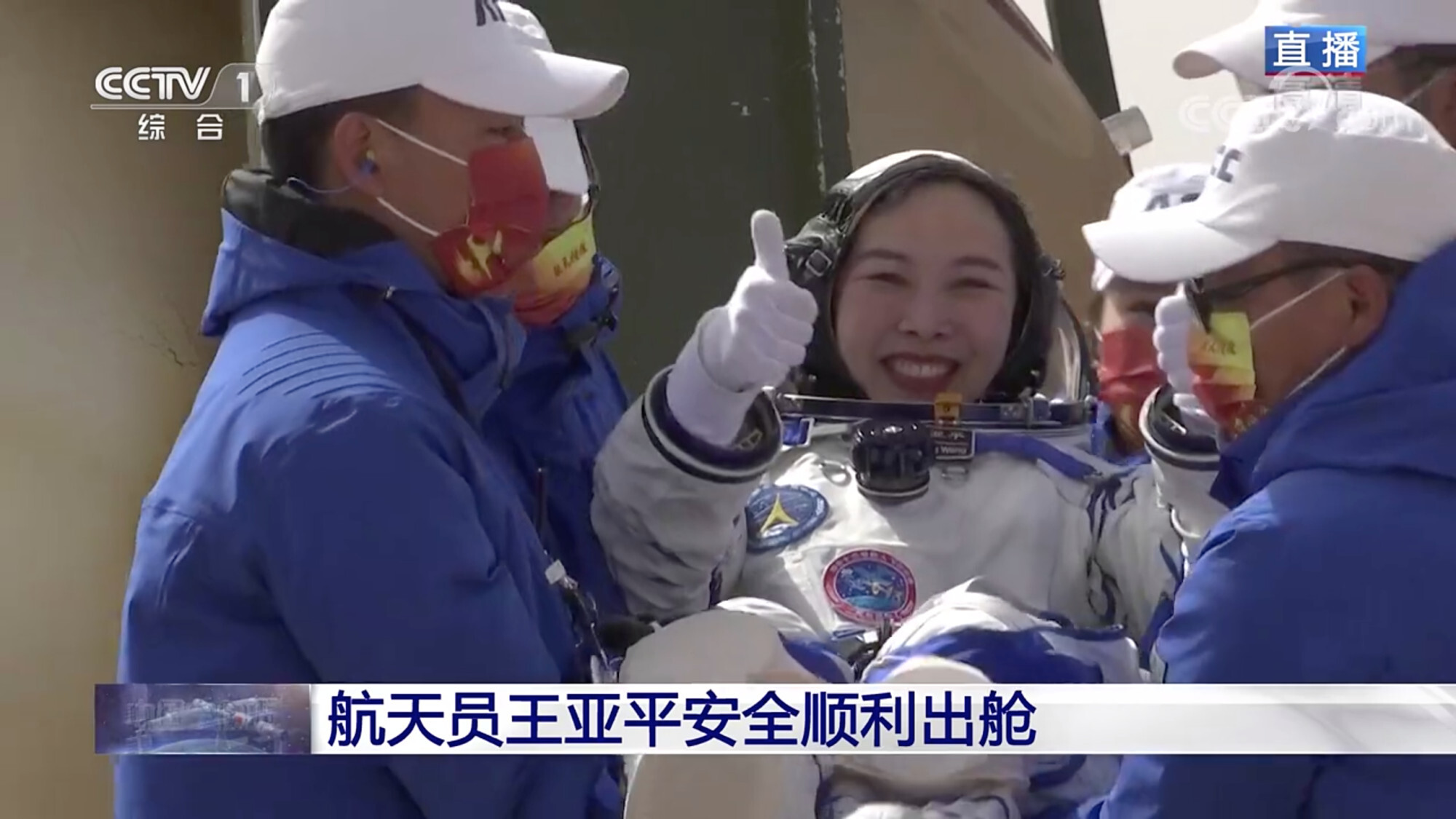
Touchdown for Chinese astronauts after six months on Tiangong space station
- After landing in Inner Mongolia, the three members of the crew return to Beijing to start the road to recovery from their mission
- Trio also have a brief moment to see their families
The Shenzhou 13 capsule landed in Inner Mongolia at around 9.56am with the probe using three parachutes to slow down from a speed of 200 metres per second to 7 metres per second as it approached the Earth.
Support teams rushed to collect debris soon after the capsule touched down at the Dongfeng landing site.
Minutes later, a medical worker entered the capsule for quick health checks as Chinese flags flew next to the capsule.
The return journey took about nine hours by using a new procedure that shortened the previous mission’s journey time of about 24 hours.
The Shenzhou 13 crew – Zhai Zhigang, Wang Yaping and Ye Guangfu – began their mission in October last year. Their 182 days in orbit nearly doubled the previous 92-day record for China’s longest space mission set by Shenzhou 12.

At around 10.46am, Zhai was the first to leave the capsule. Grinning, he was carried by a group of support staff to a white chair, where he was quickly covered by a blue blanket to keep him warm.
Before being moved to the medical truck, Zhai told state broadcaster CCTV: “I am feeling very good, reporting to the motherland and the people, we’ve completed our mission.”

Zhai told headquarters in Beijing: “I have landed safely, the return module is standing straight and I’m feeling fine.”
“At this moment I am back in the arms of the motherland. We feel really, really happy and want to report to everyone that we are safe,” Wang said.
Yang Liwei, China’s first astronaut, said the next few days would be challenging as the astronauts readjusted after six months in orbit.
Huang Weifen, the chief designer at the China Manned Space Agency, told CCTV the three astronauts would receive special care after landing as long-term space missions could reduce muscle mass and strength.
“It is the first time Chinese astronauts have stayed in orbit for six months so they will need a period of time to readapt to the Earth’s gravity,” Huang said.
The three astronauts returned to Beijing in the afternoon.
Around 5pm, a plane carrying the three astronauts landed in a military airport in the capital, where they were carried off the plane in chairs and greeted briefly by officials of the mission and their families.
Zhai’s son gave him a big hug while Ye greeted his wife with open arms. Wang’s six-year-old daughter pressed her cheek to her mother, who took a star pendant from her pocket and gave it to the little girl.
Wang’s daughter earlier told state media that her mother “was gathering stars in the space”.
Accompanied by support and medical staff, each of the astronauts were then driven to a residential base for medical isolation, further health checks and to regain strength over the next few months.
The radiation they endured in space was much higher than on Earth, and the longer they stayed, the greater the radiation exposure, with a higher risk of radiation-induced diseases and changes in the central nervous system, according to Pang Zhihao, national chief science communication expert of space exploration technology.
Pang told the official Science and Technology Daily that the Shenzhou 12 crew spent about six months in recovery after three months in space, so the six-month mission meant a longer period of observation, possibly lasting over a year.

Researchers will now launch a full evaluation of key technologies used on the space station before launching the next phase of the Tiangong mission.
An unmanned supply mission is expected next month before the Shenzhou 14 crew travel to the space station to oversee the docking of two space laboratories, named Wentian and Mengtian, to complete the configuration of the T-shaped space station by the end of the year.
The China Manned Space Agency said last month that the crews for the next two missions had been identified and were in training, but their names have yet to be announced.
The Shenzhou 13 crew were the second to live and work in the Chinese space station.
Once completed, the Tiangong would be the biggest structure built and maintained by a single country in near-Earth orbit.
Four days before the landing, Chinese President Xi Jinping inspected the Wenchang Space Launch Site in the southern island province of Hainan, where he urged engineers “to be courageous in innovation” and to attain “world-leading standards” for China’s spacecraft launch facilities, according to state news agency Xinhua.
A week before their return to the Earth, the Chinese astronauts, together with billionaire and SpaceX founder Elon Musk, were featured in an event hosted by the Chinese embassy in the US.
In a video recorded from the space station, the astronauts answered questions from US schoolchildren.
Additional reporting by Zhuang Pinghui



